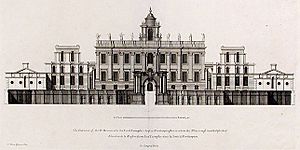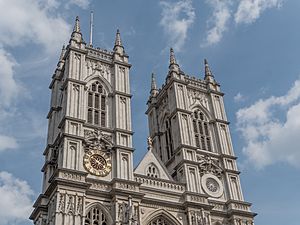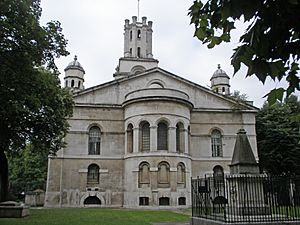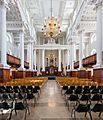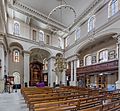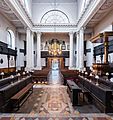Nicholas Hawksmoor facts for kids
Quick facts for kids
Nicholas Hawksmoor
|
|
|---|---|
| Born | c. 1661 Nottinghamshire, England
|
| Died | 25 March 1736 Millbank, London, England
|
| Nationality | English |
| Occupation | Architect |
| Buildings | Easton Neston Mausoleum Castle Howard Christ Church, Spitalfields St George's, Bloomsbury St Mary Woolnoth St George in the East St Anne's Limehouse St Alfege Church, Greenwich All Souls College, Oxford The Queen's College, Oxford West Towers of Westminster Abbey |
Nicholas Hawksmoor (born around 1661 – died March 25, 1736) was an important English architect. He was a key figure in the English Baroque style of architecture, which was popular in the late 1600s and early 1700s.
Hawksmoor worked with famous architects like Christopher Wren and John Vanbrugh. He helped design many well-known buildings of his time. These include parts of St Paul's Cathedral, Wren's churches in London, Greenwich Hospital, Blenheim Palace, and Castle Howard.
Contents
Life of a Master Builder
Nicholas Hawksmoor was born in Nottinghamshire, England, in 1661. His family were farmers who owned their own land. We don't know exactly where he went to school, but he likely learned more than just basic reading and writing.
When he was about 18, a famous architect named Christopher Wren heard about Hawksmoor's talent for architecture. Wren took him on as his assistant.
Learning the Craft
Hawksmoor's early sketchbooks from 1680 and 1683 show that he was still learning. They contain drawings of buildings in different English cities. His first official job was helping Wren at Winchester Palace from 1683 to 1685.
From about 1684 to 1700, Hawksmoor worked closely with Christopher Wren. They worked on big projects like Chelsea Hospital, St Paul's Cathedral, Hampton Court Palace, and Greenwich Hospital. Because of Wren's influence, Hawksmoor got important jobs. He became Clerk of the Works at Kensington Palace in 1689 and Deputy Surveyor of Works at Greenwich in 1705.
Becoming a Main Architect
In 1702, Hawksmoor designed Easton Neston, a large country house in Northamptonshire. This was the only country house he designed completely by himself.
He then worked with another famous architect, Sir John Vanbrugh. Hawksmoor helped Vanbrugh build Blenheim Palace and Castle Howard. He took charge of Blenheim Palace from 1705 after Vanbrugh had disagreements with the Duchess of Marlborough.
By 1700, Hawksmoor was recognized as a major architect. Over the next 20 years, he became one of the greatest masters of the English Baroque style. His unique style mixed ideas from ancient Rome, the Renaissance, and the English Middle Ages. Unlike many wealthy people of his time, Hawksmoor never traveled to Italy. Instead, he studied drawings and pictures of ancient Roman buildings and even plans for the Temple of Solomon.
Designing for Universities
When he was almost 50, Hawksmoor started designing buildings for the universities of Oxford and Cambridge. In 1713, he was asked to finish King's College, Cambridge. He drew up grand plans, but they were too expensive. The college also lost a lot of money in a financial crisis, so Hawksmoor's designs were never built.
He also had big plans for central Oxford, but most of these were not built either. However, he did design the Clarendon Building at Oxford. He also designed the Codrington Library and new buildings at All Souls College, Oxford. He worked on parts of Worcester College, Oxford and the entrance screen at The Queen's College, Oxford.
Hawksmoor's Six London Churches
In 1711, the government passed a law to build "Fifty New Churches" in London. A special group was formed, and Hawksmoor was appointed as one of its main architects. He and another architect, John James, stayed in charge until the group finished its work in 1733.
Only twelve churches were completed. Hawksmoor fully designed six of them, and he worked with John James on two others. His six churches are:
- St Alfege's Church, Greenwich
- St George's Church, Bloomsbury
- Christ Church, Spitalfields
- St George in the East, Wapping
- St Mary Woolnoth
- St Anne's Limehouse
These churches are his most famous independent works. Their tall spires look like Gothic towers but are decorated with new and imaginative classical details. After Christopher Wren died in 1723, Hawksmoor became the main architect for Westminster Abbey. He designed the Abbey's west towers, which were finished after his death.
Gallery of Churches
-
St Alphege's Greenwich (1712–18)
-
Christ Church, Spitalfields (1714–29)
-
St Anne's Limehouse (1714–30)
-
St George in the East (1714–29)
-
St George's Bloomsbury (1716–1731)
-
St Mary Woolnoth (1716–23)
-
St Luke's Old Street (1727–33), tower by Hawksmoor.
-
St John's Horsleydown (1727–33), tower by Hawksmoor.
Garden Buildings and Monuments
Hawksmoor also designed several structures for the gardens at Castle Howard. These include:
- The Pyramid (1728)
- The Mausoleum (1729–40), which was one of the first large, stand-alone mausoleums built in Western Europe since ancient Roman times.
- The Carrmire Gate (c.1730)
- The Temple of Venus (1731–35), which no longer exists.
At Blenheim Palace, he designed the Woodstock Gate (1723), which looks like a Triumphal arch. He also designed the Ripon Obelisk in Ripon's market place, built in 1702. At 80 feet tall, it was the first large obelisk built in Britain.
Gallery of Garden Structures
Death
Hawksmoor died on March 25, 1736, at his home in Millbank, London. He had been in poor health for the last twenty years of his life. He was buried at the church of St Botolph Shenley, Hertfordshire, Shenleybury.
Gallery of Architectural Work
-
Easton Neston House (c.1695–1710)
-
South Stoneham House (1708), Southampton
-
The Long Library (1722–25), Blenheim Palace
-
Entrance, The Queen's College Oxford (1733–36)
Hawksmoor in Modern Stories
Hawksmoor's buildings have inspired many writers and poets in the 20th century.
- His church St Mary Woolnoth is mentioned in the famous poem The Waste Land (1922) by T. S. Eliot.
- In Evelyn Waugh's novel Scoop (1938), a character lives in a "superb creation by Nicholas Hawksmoor."
- Poet Iain Sinclair wrote a poem about Hawksmoor's churches in his collection Lud Heat (1975).
- This idea was expanded by Peter Ackroyd in his novel Hawksmoor (1985). In this story, the historical Hawksmoor is imagined as a fictional character named Nicholas Dyer, and the book's main character is a detective investigating crimes linked to Hawksmoor's churches.
- Later, Alan Moore and Eddie Campbell used these ideas in their graphic novel From Hell. They suggested that Jack the Ripper might have used Hawksmoor's buildings as part of mysterious rituals. They even suggested that the locations of the churches form a special shape, like a pentagram.
Memorials
- In Towcester, Northamptonshire, there is a school named Nicholas Hawksmoor Primary School. It is built on land that used to be part of the Easton Neston estate, which Hawksmoor designed.
See also
 In Spanish: Nicholas Hawksmoor para niños
In Spanish: Nicholas Hawksmoor para niños



